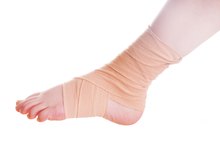Causes of a Swollen Ankle With No Pain
Painless swollen ankles occur relatively commonly, especially among older adults. The condition represents an accumulation of excess fluid in the soft tissues of the lower legs. A variety of diseases and abnormalities can lead to painless ankle swelling. In some cases, this symptom resolves quickly and does not indicate an ongoing medical problem. Persistent swollen ankles without pain, however, may indicate a serious underlying disease.
If you are experiencing serious medical symptoms, seek emergency treatment immediately.
Inactivity
Muscular activity helps push blood out of the legs toward the heart. Periods of prolonged inactivity can cause blood pooling in the lower legs, frequently leading to fluid leakage into the soft tissues and painless ankle swelling. A long car drive or airplane flight often provokes transient, painless ankle swelling. People whose occupations require prolonged sitting may also develop painless swollen ankles, also known as peripheral edema. Flexing the leg muscles while sitting and brief walking breaks can help reduce ankle swelling associated with prolonged inactivity.
- Muscular activity helps push blood out of the legs toward the heart.
- Periods of prolonged inactivity can cause blood pooling in the lower legs, frequently leading to fluid leakage into the soft tissues and painless ankle swelling.
Pregnancy
Causes of Swollen Lower Legs and Feet
Learn More
Pregnant women often develop painless swollen ankles, especially late in the pregnancy. Hormone-induced salt and water retention contributes to pregnancy-related ankle swelling. Additionally, the enlarged womb partially obstructs blood flow from the legs. The resulting increased pressure within the leg veins commonly leads to fluid leakage into the soft tissues of the ankles. Although ankle swelling typically proves harmless during pregnancy, a sudden increase in ankle swelling or severe swelling may indicate the development of preeclampsia, a serious pregnancy complication.
- Pregnant women often develop painless swollen ankles, especially late in the pregnancy.
- The resulting increased pressure within the leg veins commonly leads to fluid leakage into the soft tissues of the ankles.
Overweight and Obesity
People who are significantly overweight or obese often develop painless ankle swelling. Excess body fat compresses the leg and abdominal veins, increasing pressure within the blood vessels and promoting fluid leakage into the soft tissues. Inactivity leads to blood pooling, which further increases pressure within the leg veins. The combined effects of excess body fat and inactivity frequently leads to painless ankle swelling. Weight loss and increased physical activity can help alleviate ankle swelling caused by excess body weight.
- People who are significantly overweight or obese often develop painless ankle swelling.
- The combined effects of excess body fat and inactivity frequently leads to painless ankle swelling.
Heart Failure
What Are the Treatments for Edema in Leg?
Learn More
Persistent ankle swelling without pain is a common symptom among people living with moderate to severe heart failure. The weakened pumping capacity of the heart causes blood pooling in the legs and water retention by the kidneys. These factors frequently lead to painless edema of the ankles, feet and lower legs 2. A sudden increase in ankle swelling may indicate worsening heart failure.
- Persistent ankle swelling without pain is a common symptom among people living with moderate to severe heart failure.
Kidney Disease
Painless swelling of the ankles is a common symptom of acute or chronic kidney disease. The kidneys maintain normal water and salt balance in the body. Kidney disease frequently causes abnormal salt and water retention, resulting in fluid overload and leakage into the soft tissues 5. Salt restriction may help reduce peripheral edema in people with kidney-related ankle swelling, but any dietary change should be discussed with the treating doctor.
- Painless swelling of the ankles is a common symptom of acute or chronic kidney disease.
- Salt restriction may help reduce peripheral edema in people with kidney-related ankle swelling, but any dietary change should be discussed with the treating doctor.
Other Causes
A number of other medical conditions can lead to painless swelling of the ankles. Liver cirrhosis or failure can lead to this symptom due to complex mechanisms that lead to salt and water retention 5. Severe malnutrition, especially with inadequate protein intake, can also lead to fluid leakage into the soft tissues of the lower legs.
An over- or under-active thyroid gland might also cause painless ankle swelling. Sleep apnea is a frequently overlooked possible cause of painless ankle edema. Previous pelvic surgery or radiation treatment to the lower abdomen or pelvis can potentially lead to ankle swelling due to lymphatic system damage in these areas. Tumors in these areas are another consideration if more common causes have been excluded.
Reviewed by: Tina M. St. John, M.D.
- A number of other medical conditions can lead to painless swelling of the ankles.
- Sleep apnea is a frequently overlooked possible cause of painless ankle edema.
Unless there is an obvious cause, such as pregnancy or a recent long car ride, see your doctor as soon as possible if you develop painless swelling of your ankles. While most causes are not immediately life-threatening, many of the possible underlying conditions are serious. Seek immediate medical care if you have existing heart, kidney or liver failure and notice increased ankle swelling accompanied by shortness of breath, dizziness, lightheadedness or confusion.
Related Articles
References
- Family Practice Notebook: Generalized Edema Below the Diaphragm
- Journal of the American Board of Family Medicine: Approach to Leg Edema of Unclear Etiology
- American Family Physician: Edema: Diagnosis and Management
- Merck Manual Professional Version: Edema
- QJM: Fluid Retention in Cirrhosis: Pathophysiology and Management
- Mizel MS, et al. "Evaluation and Treatment of Chronic Ankle Pain" J. Bone Joint Surg. Am., Mar 2004; 86: 622 - 632.
Writer Bio
Dr. Tina M. St. John owns and operates a health communications and consulting firm. She is also an accomplished medical writer and editor, and was formerly a senior medical officer with the U.S. Centers for Disease Control and Prevention. St. John holds an M.D. from Emory University School of Medicine.








